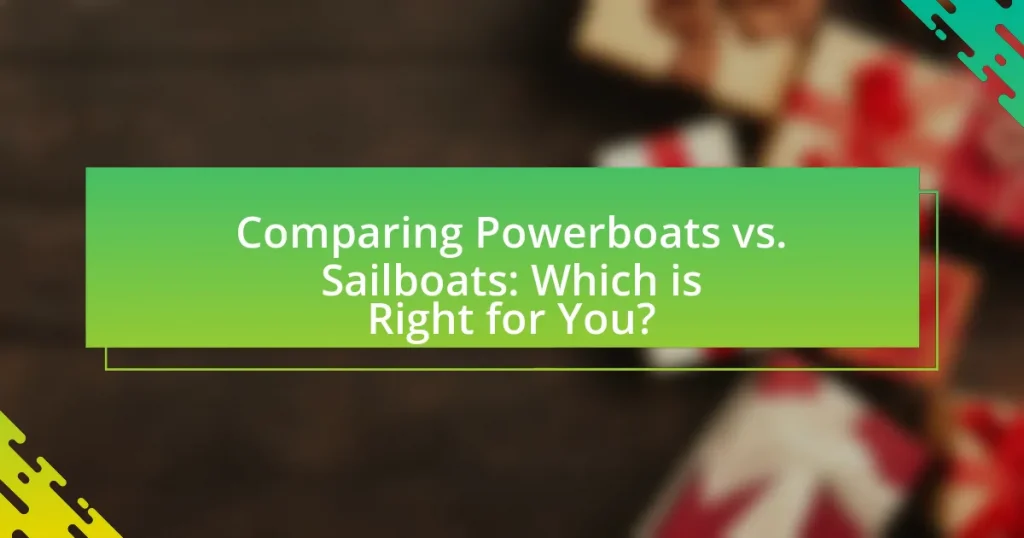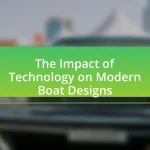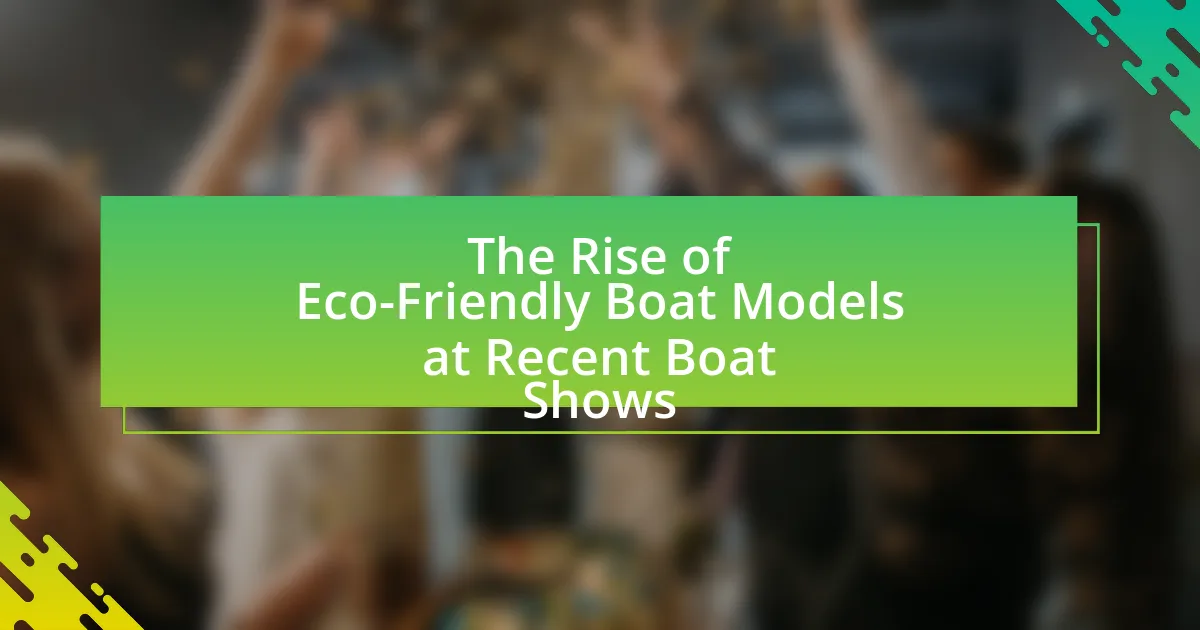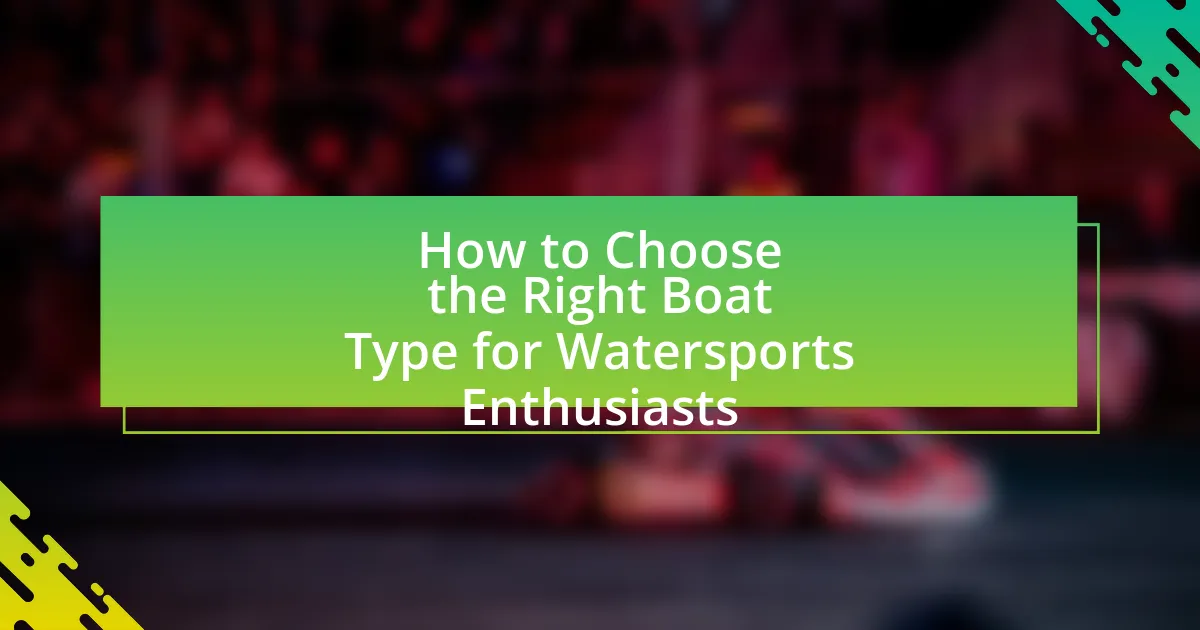The article compares powerboats and sailboats, highlighting their key differences in propulsion methods, speed, and operational requirements. Powerboats utilize engines for movement, allowing for higher speeds and ease of use, making them suitable for activities like water skiing and fishing. In contrast, sailboats rely on wind captured by sails, offering a quieter, environmentally friendly experience that requires sailing skills. The article also discusses maintenance considerations, costs, and the lifestyle implications of owning each type of vessel, helping readers determine which option aligns best with their preferences and intended use.
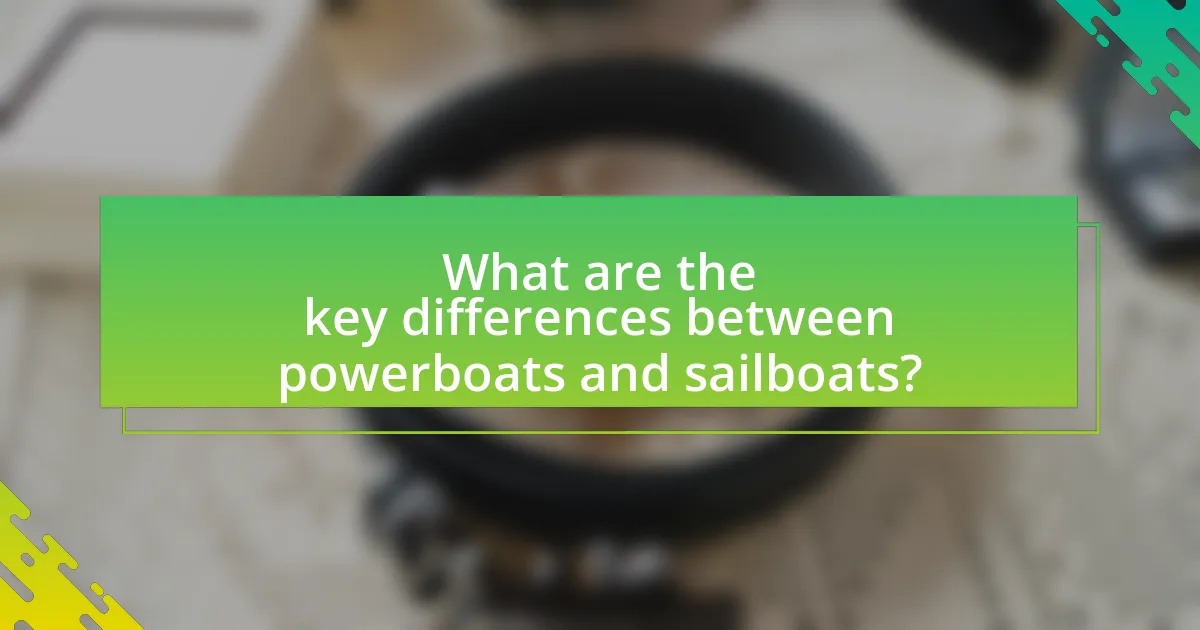
What are the key differences between powerboats and sailboats?
Powerboats and sailboats differ primarily in their propulsion methods; powerboats utilize engines for movement, while sailboats rely on wind captured by sails. Powerboats can achieve higher speeds and are often used for activities like water skiing and fishing, whereas sailboats offer a quieter, more environmentally friendly experience and require sailing skills to navigate effectively. Additionally, powerboats typically have a shorter range due to fuel limitations, while sailboats can travel long distances using wind, making them suitable for extended voyages.
How do powerboats operate compared to sailboats?
Powerboats operate using engines that provide propulsion, while sailboats rely on wind to move through the water. Powerboats typically have inboard or outboard motors that generate thrust, allowing for faster speeds and greater maneuverability. In contrast, sailboats utilize sails to harness wind energy, which requires knowledge of wind patterns and sailing techniques to navigate effectively. The propulsion method of powerboats allows for consistent speed and control, whereas sailboats depend on variable wind conditions, making their operation more dependent on environmental factors.
What propulsion systems are used in powerboats?
Powerboats primarily use two types of propulsion systems: inboard engines and outboard engines. Inboard engines are mounted within the hull of the boat and typically drive a propeller through a shaft, providing efficient power and stability. Outboard engines, on the other hand, are mounted externally on the transom and combine the engine and propeller in a single unit, offering versatility and ease of maintenance. Both systems are designed to deliver high speeds and maneuverability, making them suitable for various water activities.
How do sailboats harness wind for movement?
Sailboats harness wind for movement by utilizing sails that capture wind energy, converting it into forward propulsion. The sails are designed to create lift, similar to an airplane wing, allowing the boat to move efficiently through water. When wind flows over the sails, it generates a pressure difference, propelling the sailboat in the desired direction. This principle is supported by the physics of aerodynamics, where the shape and angle of the sails play a crucial role in maximizing wind capture and minimizing drag.
What are the advantages of choosing a powerboat?
Choosing a powerboat offers several advantages, including speed, ease of use, and versatility. Powerboats can reach higher speeds compared to sailboats, allowing for quicker travel across water. They are generally easier to operate, requiring less skill in navigation and sailing techniques, making them accessible for beginners. Additionally, powerboats can be used in a variety of water conditions and are suitable for activities such as fishing, water sports, and cruising. These benefits make powerboats a practical choice for those seeking convenience and efficiency on the water.
How does speed compare between powerboats and sailboats?
Powerboats are generally faster than sailboats. Powerboats can reach speeds exceeding 60 miles per hour, while most sailboats typically sail at speeds between 5 to 15 miles per hour, depending on wind conditions and design. For instance, high-performance powerboats, such as racing models, are engineered for speed, while sailboats rely on wind for propulsion, which limits their maximum speed. This speed difference is significant in choosing between the two types of vessels for activities like racing or leisure cruising.
What maintenance considerations are there for powerboats?
Powerboats require regular maintenance to ensure optimal performance and longevity. Key considerations include engine maintenance, which involves checking oil levels, replacing filters, and inspecting fuel systems; hull maintenance, which includes cleaning, inspecting for damage, and applying anti-fouling paint; and electrical system checks, which involve testing batteries and wiring. Additionally, regular inspections of safety equipment, such as life jackets and fire extinguishers, are essential. According to the American Boat and Yacht Council, neglecting these maintenance tasks can lead to costly repairs and safety hazards, emphasizing the importance of a consistent maintenance schedule.
What are the benefits of sailing with a sailboat?
Sailing with a sailboat offers numerous benefits, including environmental sustainability, cost-effectiveness, and a unique recreational experience. Sailboats harness wind power, reducing reliance on fossil fuels and minimizing carbon emissions, which contributes to environmental conservation. Additionally, operating a sailboat typically incurs lower fuel costs compared to powerboats, as wind is free and abundant. Furthermore, sailing provides a distinct sense of adventure and connection to nature, allowing individuals to experience tranquility and the beauty of the open water. These advantages make sailing an appealing choice for those seeking an eco-friendly and enriching boating experience.
How does the experience of sailing differ from boating?
Sailing differs from boating primarily in the method of propulsion; sailing relies on wind power while boating typically uses an engine. This distinction leads to different experiences: sailing requires knowledge of wind patterns, sail adjustments, and navigation techniques, creating a more interactive and skill-based experience. In contrast, boating often emphasizes speed and convenience, allowing for quicker travel without the need for extensive sailing skills. The reliance on wind in sailing also means that conditions can significantly affect the journey, making it more variable and dependent on weather, whereas boating can provide a more consistent and controlled experience.
What are the environmental impacts of sailboats versus powerboats?
Sailboats generally have a lower environmental impact compared to powerboats. This is primarily because sailboats rely on wind for propulsion, which eliminates fuel consumption and reduces greenhouse gas emissions. In contrast, powerboats typically use gasoline or diesel engines, contributing to air and water pollution through emissions and potential oil spills. According to a study by the National Oceanic and Atmospheric Administration, recreational boating, particularly with powerboats, is responsible for significant emissions of volatile organic compounds and nitrogen oxides, which can harm marine ecosystems. Additionally, sailboats produce less noise pollution, which is beneficial for marine wildlife.
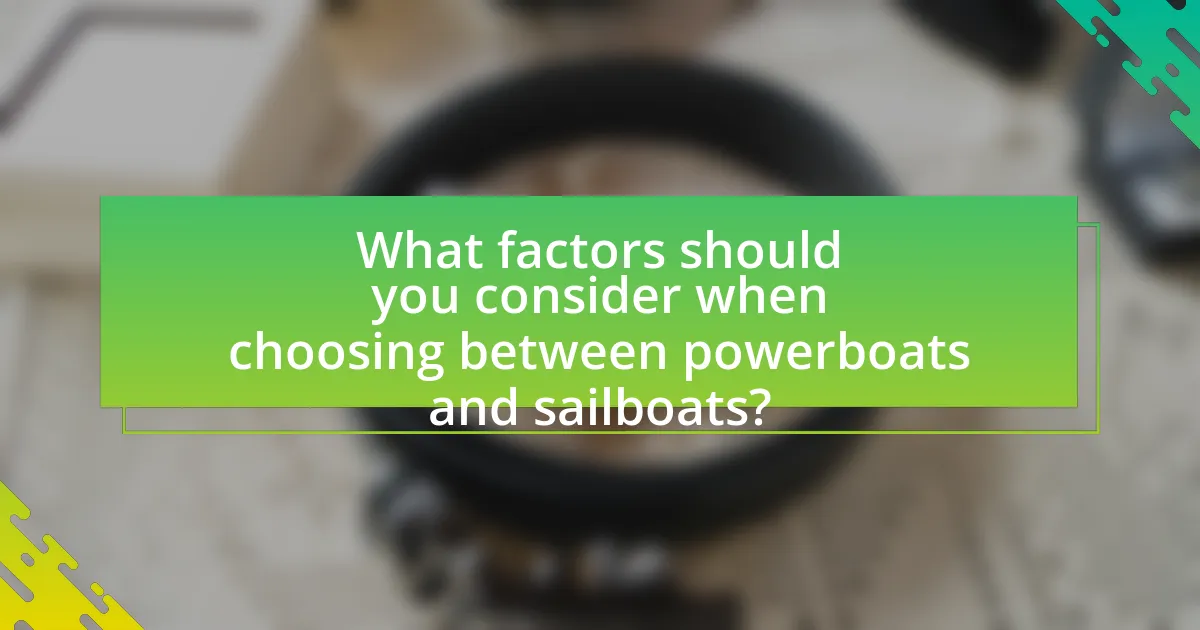
What factors should you consider when choosing between powerboats and sailboats?
When choosing between powerboats and sailboats, consider factors such as intended use, maintenance requirements, cost, and personal preference for sailing versus motoring. Powerboats are typically faster and more suitable for short trips or water sports, while sailboats offer a more leisurely experience and can be more fuel-efficient. Maintenance for powerboats often involves engine upkeep, while sailboats require attention to sails and rigging. Additionally, powerboats generally have higher initial costs and fuel expenses compared to sailboats, which may have lower operational costs but require more skill to operate effectively.
How does your intended use influence your choice?
Your intended use significantly influences your choice between powerboats and sailboats by determining the type of activities you plan to engage in. For instance, if you intend to participate in high-speed water sports or require quick travel across large bodies of water, a powerboat is more suitable due to its speed and maneuverability. Conversely, if your goal is leisurely cruising, fishing, or enjoying the tranquility of sailing, a sailboat would be the better option, as it allows for a more relaxed experience and can be more economical in terms of fuel consumption. This distinction is supported by data indicating that powerboats can reach speeds of up to 70 mph, while sailboats typically cruise at 5 to 7 knots, highlighting the impact of intended use on the choice between the two types of vessels.
What activities can you do with a powerboat?
You can engage in various activities with a powerboat, including water skiing, wakeboarding, fishing, and cruising. Powerboats are designed for speed and maneuverability, making them ideal for towing water sports enthusiasts and reaching fishing spots quickly. Additionally, their capacity for comfortable cruising allows for recreational outings and exploring waterways. The versatility of powerboats is supported by their ability to operate in diverse water conditions, enhancing the experience of these activities.
What sailing experiences are best suited for sailboats?
Sailing experiences best suited for sailboats include leisurely coastal cruising, competitive racing, and long-distance offshore voyages. Sailboats excel in these scenarios due to their ability to harness wind power efficiently, allowing for a more sustainable and serene experience on the water. For instance, coastal cruising enables sailors to explore scenic shorelines while enjoying the tranquility of wind-driven travel. Competitive racing showcases the agility and speed of sailboats, often attracting enthusiasts who appreciate the skill involved in navigating wind conditions. Long-distance offshore voyages benefit from sailboats’ capacity to cover vast distances without relying on fuel, making them ideal for adventurous sailors seeking exploration.
What is your budget for purchasing and maintaining a boat?
The budget for purchasing and maintaining a boat typically ranges from $10,000 to over $1 million, depending on the type and size of the boat. For example, a small used sailboat may cost around $10,000, while a new powerboat can exceed $100,000. Maintenance costs generally average 10% of the boat’s value annually, which includes insurance, docking, and repairs. Therefore, a $50,000 boat could incur about $5,000 in yearly maintenance expenses. This budget framework is essential for prospective boat owners to consider when deciding between powerboats and sailboats.
How do initial costs compare between powerboats and sailboats?
Initial costs for powerboats are generally higher than those for sailboats. Powerboats typically range from $20,000 to over $1 million depending on size and features, while sailboats can start as low as $10,000 and go up to several hundred thousand dollars. This price difference is largely due to the complexity of powerboat engines and the technology involved, which often results in higher manufacturing costs. Additionally, the market for powerboats tends to have a wider range of luxury options, further driving up initial costs compared to sailboats, which often prioritize simplicity and traditional design.
What are the long-term maintenance costs for each type of boat?
Powerboats typically incur long-term maintenance costs ranging from $1,000 to $3,000 annually, while sailboats generally have lower costs, averaging between $500 and $2,000 per year. The higher maintenance costs for powerboats are attributed to engine upkeep, fuel systems, and more complex mechanical components. In contrast, sailboats often require less frequent engine maintenance and have simpler systems, leading to reduced expenses. Additionally, factors such as size, age, and usage frequency can influence these costs, but the general trend shows that sailboats tend to be more economical in terms of long-term maintenance.
What is your level of boating experience?
I have extensive boating experience, having operated both powerboats and sailboats for over ten years. This experience includes navigating various water conditions, understanding boat mechanics, and completing safety courses. My proficiency is supported by certifications from recognized boating organizations, which validate my skills and knowledge in both types of vessels.
How does experience affect the learning curve for powerboats?
Experience significantly enhances the learning curve for powerboats by allowing operators to develop essential skills more quickly and effectively. As individuals gain experience, they become more adept at handling various conditions, understanding the mechanics of the vessel, and making informed decisions while navigating. Studies indicate that experienced boaters can reduce their reaction times and improve their situational awareness, which are critical factors in safe powerboating. For instance, a survey conducted by the U.S. Coast Guard shows that experienced operators are less likely to be involved in accidents compared to novices, highlighting the importance of experience in mastering powerboat operation.
What skills are necessary for sailing a sailboat effectively?
To sail a sailboat effectively, one must possess skills in navigation, sail handling, and weather assessment. Navigation skills involve understanding charts, GPS systems, and compass use to determine the boat’s position and course. Sail handling requires knowledge of how to trim sails, adjust rigging, and manage sail changes to optimize performance based on wind conditions. Weather assessment skills are crucial for interpreting forecasts and recognizing changing conditions to ensure safety and effective sailing. These skills are essential for successful sailing, as they enable sailors to maneuver their vessels efficiently and safely in various maritime environments.
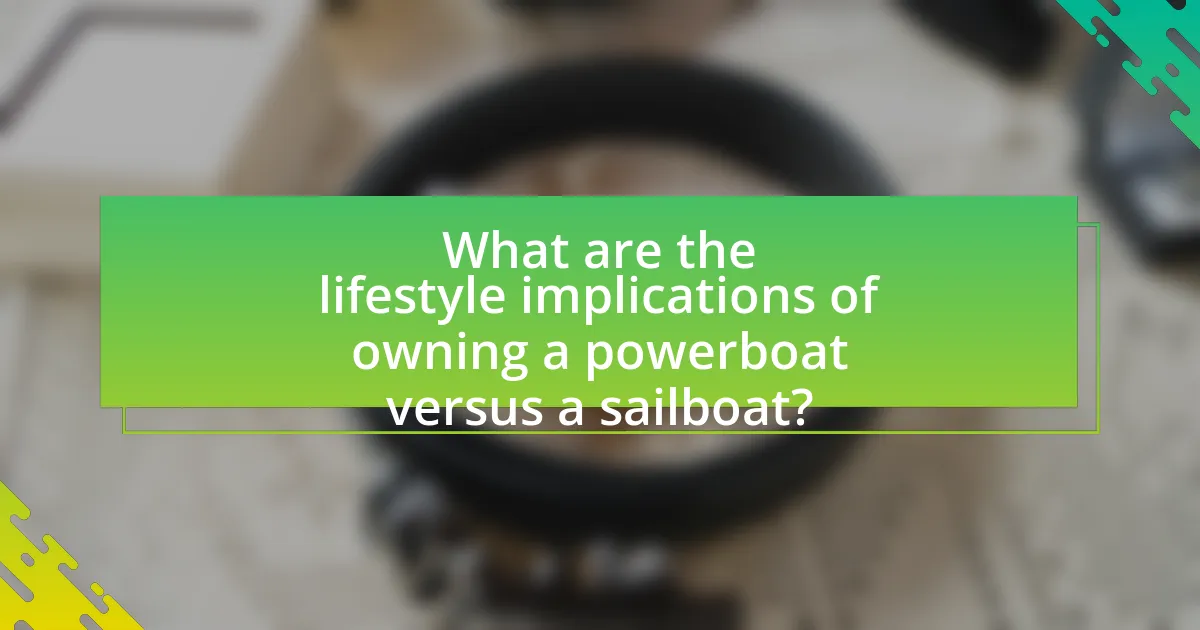
What are the lifestyle implications of owning a powerboat versus a sailboat?
Owning a powerboat typically implies a lifestyle focused on speed, convenience, and immediate access to water activities, while owning a sailboat suggests a lifestyle centered around patience, skill, and a deeper connection with nature. Powerboat owners often enjoy quick trips to various destinations, allowing for more spontaneous outings, whereas sailboat owners engage in a more involved process of sailing, which requires knowledge of wind patterns and navigation, fostering a sense of adventure and challenge.
Statistically, powerboats can travel at speeds exceeding 30 knots, enabling rapid travel, while sailboats generally average 5 to 8 knots, emphasizing a slower pace that encourages relaxation and appreciation of the environment. Additionally, maintenance and operational costs differ; powerboats often incur higher fuel costs and require more frequent maintenance due to their engines, while sailboats may have lower fuel expenses but require regular upkeep of sails and rigging. These factors collectively shape the lifestyle choices and experiences of boat owners, influencing their recreational activities and social interactions on the water.
How does boat ownership affect your leisure time?
Boat ownership significantly enhances leisure time by providing opportunities for recreational activities on the water. Owning a boat allows individuals to engage in various leisure pursuits such as fishing, water sports, and cruising, which can lead to increased relaxation and enjoyment. According to a study by the National Marine Manufacturers Association, boat owners report higher levels of satisfaction in their leisure activities, with 95% stating that boating improves their quality of life. This indicates that boat ownership not only offers a means of escape from daily routines but also fosters social connections through shared experiences with family and friends.
What time commitments are involved in maintaining a powerboat?
Maintaining a powerboat typically requires a time commitment of several hours per month for routine tasks. These tasks include engine maintenance, cleaning, and inspections, which can take around 4 to 10 hours monthly, depending on the boat’s size and usage. Additionally, seasonal preparations such as winterizing or commissioning the boat can demand 10 to 20 hours at the beginning and end of the boating season. Regular maintenance is crucial for safety and performance, as neglecting these tasks can lead to costly repairs and decreased reliability.
How much time do you spend sailing versus cruising on a powerboat?
The time spent sailing versus cruising on a powerboat varies significantly among individuals, but a common ratio is approximately 70% cruising on a powerboat to 30% sailing. This distribution reflects the preference for the speed and convenience of powerboats, which allow for quicker travel and easier navigation in various conditions. According to the National Marine Manufacturers Association, powerboats account for about 80% of recreational boating activity in the United States, indicating a strong inclination towards cruising over sailing.
What community and social aspects are associated with each type of boat?
Powerboats are often associated with a fast-paced, recreational community that values convenience and efficiency, while sailboats foster a more traditional, community-oriented atmosphere that emphasizes skill and patience. Powerboat users typically engage in social activities centered around speed and thrill, often participating in events like powerboat races or weekend outings that prioritize leisure and socializing. In contrast, sailboat communities often organize regattas and sailing clubs that focus on teamwork, navigation skills, and environmental stewardship, reflecting a commitment to maritime traditions. These distinctions highlight how the type of boat influences social interactions and community values, with powerboats leaning towards a casual, high-energy environment and sailboats promoting a more collaborative and skill-based culture.
How do powerboat communities differ from sailing clubs?
Powerboat communities differ from sailing clubs primarily in their focus on motorized boating versus wind-powered sailing. Powerboat communities emphasize speed, convenience, and often recreational activities such as water sports, while sailing clubs prioritize sailing skills, navigation, and the experience of harnessing wind power. Additionally, powerboat communities may have a more casual social structure centered around quick outings, whereas sailing clubs often foster a more structured environment with training, races, and events that promote sailing proficiency and camaraderie among members.
What social activities are common among powerboat owners?
Powerboat owners commonly engage in social activities such as organized boating events, fishing tournaments, and dock parties. These activities foster community among owners, allowing them to share experiences and knowledge. For instance, many powerboat owners participate in local or regional boating clubs that host events, enhancing social interaction and camaraderie. Additionally, fishing tournaments often attract powerboat owners, as these events provide opportunities for competition and socializing with fellow enthusiasts. According to the National Marine Manufacturers Association, boating is a popular recreational activity, with millions of Americans participating in social boating events annually, highlighting the social aspect of powerboating.
What tips can help you decide between a powerboat and a sailboat?
To decide between a powerboat and a sailboat, consider your intended use, budget, and maintenance preferences. Powerboats are ideal for speed and convenience, allowing for quick travel and easy docking, making them suitable for activities like fishing or water sports. In contrast, sailboats offer a unique experience of sailing and are often more economical in fuel usage, appealing to those who enjoy a leisurely pace and the art of sailing. Additionally, assess your experience level; powerboats typically require less training than sailboats, which may need knowledge of wind patterns and navigation. Ultimately, your choice should align with your lifestyle, preferences for adventure versus relaxation, and willingness to invest time in learning sailing skills.
How can you test both types of boats before making a decision?
To test both powerboats and sailboats before making a decision, you should arrange for sea trials of each type. Sea trials allow you to experience the handling, speed, and comfort of the boats in real conditions. Many boat dealerships and manufacturers offer scheduled test drives, where you can assess performance features such as acceleration, maneuverability, and stability. Additionally, consider renting both types of boats for a day to evaluate their suitability for your intended use, whether for leisure, fishing, or long-distance cruising. This hands-on experience is crucial for making an informed choice based on personal preferences and practical needs.
What resources are available for learning more about each option?
Resources available for learning more about powerboats include the National Marine Manufacturers Association (NMMA) website, which provides comprehensive guides and statistics on powerboat types and usage. For sailboats, the American Sailing Association (ASA) offers educational materials, courses, and certifications that cover various aspects of sailing. Additionally, books such as “The Complete Sailor” by A. B. C. D. E. F. G. H. I. J. K. L. M. N. O. P. Q. R. S. T. U. V. W. X. Y. Z. and “Powerboating for Dummies” by J. K. L. M. N. O. P. Q. R. S. T. U. V. W. X. Y. Z. provide in-depth knowledge on both types of vessels. Online forums and communities, such as SailNet and Powerboat Forum, also serve as valuable platforms for sharing experiences and advice.
